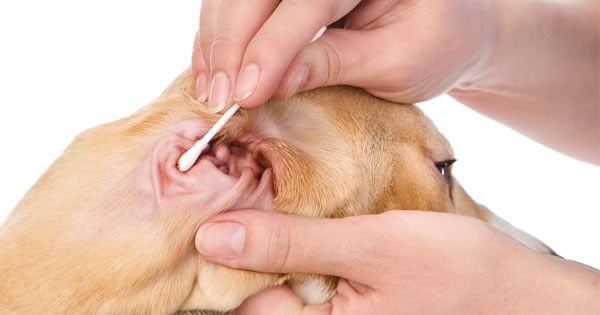Just like humans, dogs are susceptible to ear infections. In fact, ear infection in dog is one of the most common reasons that veterinarians see canines. Ear infections can range from mild to severe, causing reactions that range from gentle head shaking to aggressive scratching. If you think that your dog has an ear infection, make an appointment with your pet’s veterinarian as soon as possible.

Dog Ear Infection Symptoms
Ear infection in dog is fairly common. Most dogs suffer with an ear infection at some point in their lives. Symptoms of ear infection in dogs includes head shaking, scratching at the ears, redness in the ears and on the underside of the ear flaps, and an odor in the ears. The smell of ear infection in dog is caused by yeast or other bacteria. The same bacterium that causes the odor causes a reddish-brown waxy substance to build up in the ear canal and in the folds of the ears.
Dogs that shake their heads violently may develop hematomas in the ear flaps. A hematoma occurs when the skin that makes up the ear flap separates and blood leaches in. A large, blood-filled lump appears on the dog’s ear flap. Veterinary intervention is necessary when a hematoma is present.
Home Remedies for Dog Ear Infection
Most ear infections cannot be cured with home remedies, but home remedies can help to prevent ear infections in dogs. One such home remedy is a vinegar and water solution. Dog owners can mix two tablespoons of white vinegar to one cup of lukewarm water. Fill the dog’s ear canal with the mixture, massage the base of the ears, and allow the dog to shake its head. Wipe the dog’s ears with a gauze pad or other soft, small towel. Once ears are cleaned, they can be maintained with by daily cleanings with a dry cotton ball or pad.
Many pet owners find that ear infection in dogs is the result of food or other allergies. If you suspect that your dog is allergic to its food, a dietary trial can help. Clean your dog’s ears, change its food to one that contains ingredients to which your dog has not been previously exposed, and see how the ears are affected. Some dog owners have discovered that feeding a grain-free diet with a novel protein source reduces the frequency of dog ear infection.
Treating Dog Ear Infections
If your dog has developed an ear infection, veterinary intervention is necessary. Your veterinarian will take a swab of each of your dog’s ears, smear the wax and debris on a slide, and look at the slide under a microscope. This allows your veterinarian to determine exactly what is growing in your dog’s ears.
Once the source of your dog’s ear infection is discovered, your veterinarian will clean out your dog’s ears with a medicated cleanser and instill drops or ointment into the canal. Your dog will be prescribed cleaner and medication to take home. It is always recommended that you have your dog’s ears checked again once you have delivered the medication for the prescribed amount of time. This allows the veterinarian to see if the infection has cleared or if medication needs to be continued. Ear infection in dogs can be difficult to resolve.
At-Risk Breeds
Dog breeds most at risk of developing ear infections are those that swim or have pendulous ears. Labradors, Basset Hounds and Cocker Spaniels are most at risk. Dogs with food and environmental allergies are also at a higher risk of developing ear infections than typical dogs.